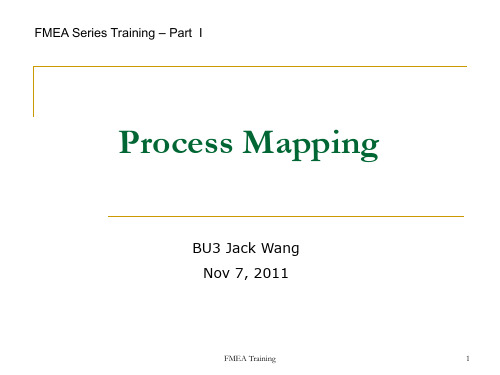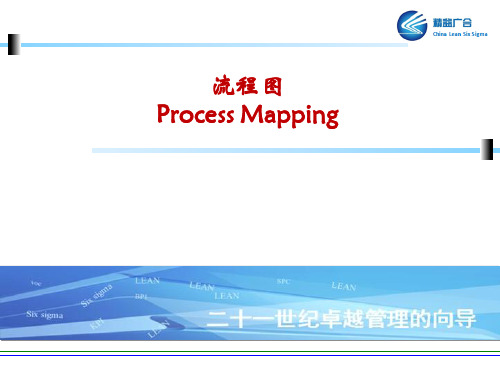Process Mapping work flow and layout
- 格式:ppt
- 大小:370.50 KB
- 文档页数:34



业务流程梳理英文Business process mapping is a critical step in understanding and improving the efficiency of a company's operations. The process involves identifying, analyzing and documenting the various steps and activities that make up a particular business process. By creating a visual representation of the workflow, business process mapping helps organizations identify bottlenecks, redundancies and inefficiencies that may be hindering their performance. Through this exercise, companies can streamline their operations, reduce costs and improve overall productivity.业务流程梳理是理解和提高公司运营效率的关键步骤。
该过程包括识别、分析和记录组成特定业务过程的各种步骤和活动。
通过创建工作流程的可视化表示,业务流程梳理帮助组织识别可能妨碍业绩的瓶颈、冗余和低效。
通过这一练习,公司可以简化运营、降低成本并提高整体生产力。
One of the key benefits of business process mapping is that it provides a clear understanding of how tasks are completed within an organization. By mapping out each step in a process, employees can see how their work fits into the larger picture and how it impactsother parts of the organization. This level of transparency helps employees understand the importance of their roles and encourages collaboration across departments. It also allows managers to easily identify areas for improvement and implement changes that will have a positive impact on the organization as a whole.业务流程梳理的一个关键好处是它提供了清晰的了解组织内部任务完成情况的方式。

现场改善工具-OSKKKKaizen Activities following the OSKKK process-Observe, Standardize, Kaizen Flow and Process, Kaizen Equipment, Kaizen Layout现场改善活动工具应用OSKKK,包含观察,标准化,改善物流,改善设备以及最后改善布局Observation is the first step, the ability to improve is contingent upon the ability to observe and understand the existing process.观察是第一步,改善的能力取决于观察和理解现有过程的能力Observation must not only focus on gathering sufficient process information to readily utilize the MSD tools, but also on identifying sources of waste including machine and material stoppages and sources of variation in material and information flow观察不仅必须集中于收集足够的过程信息以便随时利用MSD工具,而且还必须确定浪费的来源,包括机器和材料的停止以及材料和信息流变化1> ObserveStudy/observe/document current stateBreak down process into discrete stepsIdentify sources of variation in 3 flows: Material, people, InformationWatch for machine, and material stoppagesLook for waste-operator&machine, motionsUse MSD Tools to assist-Value stream mapping;Takt time analysis;Precedence diagram;Manufacturing sequence;Machine balance chart;Operator/process layout;Operator balance chart;Containerization/part presentation观察-研究观察当前状态;断点;识别变化点-物料,人,信息流;观察机器和物料停滞;观察人,机浪费;可以使用工具来识别,包含-价值流图,节拍时间分析,顺序图,生产顺序,设备平衡表,线体布局,人员平衡表,周转箱标准化和物料上线方式设计2> StandardizeCompare observation to available documented standardsStandardize manual work methods& motions标准化-将观察结果和文档进行比较并标准化作业方法和动作3>Kaizen flow/process improvement3.1>Observe-Use VSM, TAKT Time, precedence diagram, manufacturing sequence, operator balance, containerization & part presentation to study & observe current stateImprove material flow and parts presentationReduce, simplify and balance motions and transferable work Consider de-coupling and /or the use of in –process buffers Improve information flow3.2>mock-up then implement改善流程/制程-使用价值流图,节拍时间,生产顺序,顺序图,人员平衡,内部容器标准化以及物料上线方式去研究和观察当前现状4>Kaizen-equipment improvement4.1>Use Precedence diagram, manufacturing sequence& machine balance, to study& observe current stateReduce, simplify and balance machine motion and cycle time;Support the operator;Improve utilization;Identify error-proofing opportunities4.2>mock-up then implement改善设备-使用顺序图,组装顺序,设备平衡表去研究和观察当前现状;降低,简化平衡设备作业时间简化作业员工;提高利用率;识别防错5>Kaizen-Layout improvement5.1>Use Precedence diagram, manufacturing sequence& operator/process layout to study& observe current stateDevelop layout to support system rebalanceImplement parts presentation, Material & information flow & equipment improvement5.2>Mock-up then implement改善布局使用顺序图,组装工序,布局图去观察和研究当前现状;生成最新的布局来平衡各个环节,实施物料上线方式,物流和信息流以及设备改善After source of waste are identified, the next step of improvement is to establish standardized work practices. Standardization provides the baseline form which improvement starts. The proves of observation and standardization must be repeated until all people who perform the job do the same thing all the time otherwise consistent improvement is not possible 识别浪费后,下一步的改进是建立标准化作业,标准化提供优化的基础。


简述野外地形图测图的流程英文回答:Mapping terrain in the wilderness involves several steps to accurately represent the features and topography of the area. Here is a general outline of the process:1. Preliminary research: Before heading out into the field, I gather as much information as possible about the area I will be mapping. This includes studying existing maps, satellite imagery, and any available data on the terrain. It helps me understand the general layout and identify key features to focus on during the fieldwork.2. Fieldwork: Once I have a good understanding of the area, I venture into the wilderness equipped with essential tools such as a compass, GPS device, measuring tape, and a notebook. I explore the terrain, carefully observing and noting down the key features such as rivers, mountains, valleys, and vegetation.3. Surveying: To accurately measure the dimensions and elevations of the terrain, I use various surveying techniques. For example, I may employ a theodolite or total station to measure angles and distances. This allows me to create an accurate representation of the topography, including contour lines and elevation data.4. Data collection: In addition to physical measurements, I also collect other relevant data during the fieldwork. This may include soil samples, water quality measurements, or photographs of significant landmarks. These additional data points provide valuable context and information for the map.5. Map creation: Once I have gathered all the necessary data, I proceed to create the actual map. This involves transferring the field measurements onto a base map or creating a new one from scratch. I use specialized software, such as GIS (Geographic Information System), to accurately represent the terrain features and incorporate thecollected data.6. Accuracy check: After completing the initial map, I conduct a thorough accuracy check. This involves cross-referencing the map with the field notes, verifying the measurements, and ensuring the map accurately reflects the terrain. Any discrepancies or errors are corrected during this stage.7. Finalization: Once I am satisfied with the accuracy and quality of the map, I finalize it by adding labels, legends, and other necessary elements. I also ensure that the map is easy to understand and visually appealing.中文回答:野外地形图测图的流程包括以下几个步骤,以准确地呈现地形特征和地势:1. 初步调查,在进入野外之前,我会尽可能收集有关测图区域的信息。
流程图表现形式Flowcharts are commonly used in various industries to visually represent processes and workflows. They provide a clear and easy-to-understand way to outline the steps involved in completing a task or achieving a goal. In a world where information overload is a common problem, flowcharts offer a simple and efficient way to break down complex processes into manageable chunks.流程图通常用于各行各业,以可视化地表示流程和工作流程。
它们提供了一种清晰且易于理解的方法,来概述完成任务或实现目标所涉及的步骤。
在信息过载普遍存在的今天,流程图为将复杂流程分解为易管理的部分提供了简单而高效的途径。
One of the key advantages of using flowcharts is that they help in identifying bottlenecks and inefficiencies in a process. By visually mapping out each step and decision point, it becomes easier to pinpoint areas where improvements can be made. This can lead to increased productivity and cost savings for businesses, as processes are streamlined and optimized.使用流程图的一个主要优势是,它们有助于识别流程中的瓶颈和低效。